...BUT THERE ARE NO SEAT-BELTS, SIR
In the last post, we talked about how we should accurately depict Faster-Than-Light travel.
Using doppler shifts and various >cough< plot devices >cough< methods of choice.
Now, this is also a guide on how to gauge the mean age of an interstellar civilization, by it's size - you will see how in a moment.
First, let's pose a problem.
Imagine how many stars there are in a 50ly radius, 100? 1k? 10k? Let's stick with 1k for now - let's say that 20% of those stars hold habitable planets we wanna settle, so 200 places to go, quite a schedule, isn't it?
So a bubble of 50ly has a volume of ~523.598,7ly³ (593,6 thousand cubic ly), or roughly 13,78ly in between stars with habitable planets (cube root of volume divided by amount).
If we plot a perfect route, that lines up every star in these roughly 13,78ly space, we get (200)*13,78 = 2756,47ly to travel.
Theoretically we could launch 200 missions at the same time, now, is it feasible? Not really, because of the sheer amount of personnel and resources to do so.
Let's say we launch a mission every 4 years, and that we take about 1 year to establish a decent outpost over there (being extremely optimist).
That gives us +1.000 years of work.
Now, the final touch is know at what speed are we traveling - let's calculate for 0,1c, then do the same for 1,0c and 10c.
(2756,47ly / 0,1c) + 1000yrs = 28.564,7yrs.
28,56kyr ago mankind had just invented pottery, who knows if we will even be around back on Earth in 28,6 thousand years?
That goes down to 3,75kyr for 1,0c - then 1,27kyr at 10c.
We see that - in very simple words - traveling at subluminal speeds sucks to an awful lot.
But when traveling at the speed of light and beyond, that time is only determined by how fast we can do stuff after getting there, once there is a point that travel is nearly instant to the destination, but people still do work at people-speed.
Now, settling all planets in a space with double the radius would take not double the time, but 8x the time (square-cube law), so even at the best of 1,27kyr at 10c, it would take ~10 thousand years to do so.
Again, it's a hell of a pain to go further and further from home even at superluminal speeds.
Things like this are the reason that - I, personally - don't believe we have been, and won't be for a long looong time, visited by any aliens. It's so unimaginably hard to do so that is just so improbable to happen, simple like that. If one wanna believe anyone has been ever able to build an empire that's 100ly in radius, well, they aren't even close to us because their radio-bubble would be at least 20kly across, and more realistically detectable in the whole galaxy by such timescales.
What I would use to explain UFOs? WHATEVER, whatever but aliens, extra-dimensional beings are 2nd in line, but I really doubt the shapes they present for a number of other reasons, leaving it blank for either a complete hoax or someone's experimental aircraft despite the denials.
TIME DILATION AND CAUSALITY ISSUES
The above equation works to figure the time dilation relative to one traveling at subluminal speeds - in other words - the time one left on Earth experiences (t'sec) during your travel time tsec.
For our first example at 0,1c, we expend over 27,56kyr traveling from our perspective, however on Earth it will be over ~27,7kyrs.
It gets worse if we wanted to go faster, at 0,95c that time for one on Earth becomes over 88,26kyr.
At 0,99962c, the perceived time would be of 1Myr.
If we want to go at superluminal speeds though, we must invert the sign to:
The above form tells you how much time has passed outside the ship while traveling at some multiple of lightspeed.
The problem is that any dilation for superluminal speeds is negative - that means if any traveler at 1,5c for 1 day, would arrive at their destination 1d19h (1,80 days) in the past relative to departure time.
That clearly violates causality, if one did such a trip to the outer Kuiper Belt and back to Earth they could interact with themselves and mess their own timeline which shouldn't be possible.
The same goes for instantaneous travel or communication.
Imagine that I sit down for a small lunch listening to the radio before flipping the switch on my spaceship, then, I travel to Saturn at 10c, and from Saturn I beam an INSTANTANEOUS message back about my experience.
The distance to Saturn in light-units is about 1h17min, so it would take me little over 7min42s to get there are 10c, relativity tells that I arrive at Saturn about 1h17min23s in the past relative to Earth's departure time...
Now, when I beam my instant message back to Earth, it will catch with my past self before the launch.
If I decide to go back 5min after or beam another message at 10c instead of instantaneous, the time dilation will cancel out plus the time it took between my arrival and the action - giving people on Earth the impression that me or the second message came back 5min after I left, even though for both of us it would have taken about 7,7 minutes.
so, yea - that's really big problem right there
THE 'PLANET OF THE APES' EFFECT
Another thing is that if you accept there is no way to travel faster than light without violating causality, then you cannot travel at THE speed of light as well, because not only it would require infinite energy to do so - but because it imposes infinite time dilation, ie, instantaneous travel, at the cost of also arriving by the End of Time.Traveling very close to c, at 99,999...99% could be virtually instantaneous to the crew but cost thousands to billions of years for those "stationary".
Which by itself is an interesting plot, oh wait, Planet of the Apes (1968) did that already.
The point I'm trying to make bringing up causality is that one crew that travels at such a considerable portion of the speed of light or/and uses cryosleep is, by default - anachronistic in nature.
Society's logistical apparatus as we know can't survive in such an environment, not in practice.
Imagine you people of present day USA, traveling to Epsilon Eridani (10,5ly) to retrieve whatever amount of tons of unnobtainium, say at 0,5c, it would take you 5,25 years to do so, while 6 years go by on Earth, then 12 years later for your family on Earth (and 10,5yrs for you) you finally come back - except now half of the US now belongs to China and the New Malasyan Federation, in other words, your boss probably isn't around anymore and all that ore now belongs to the Chinese people. GREAT, ISN'T IT? :D
Now, the faster you travel, the greater the chance of some weird shit messing up with the world you knew before you left - you are essentially a Time-Traveler, and the only constant environment and people you will ever know from this point onwards are your ship and crew.
This stability may not be really a problem for short-term effects like one or two decades, but once things get to life-time lengths - things start to get really complicated with the logistics of it as I already said. Because of this, there is no real reason for like alien invasions to take place because they need water or some super valuable mineral, because when they return home their people will be long gone already.
5 QUASI-RULES FOR A NEAR-LIGHTSPEED TRAVELER
#1. The ship and crew are your only home and family now.
#2. What belongs in a system, stays on that system - in general it's just not worth bringing it to your homeplanet.
#3. Only departure from a system when you are absolutely sure you are done with business - there is no time for mistkaes.
#4. Every jump means you will find a new world, both geographically and culturally different, be cautious and comprehensive with the people of the future, you're the caveman there.
#5. Your words have absolutely more power than everyone else's depending on one's perspective, your experiences are always fresher than everyone else's and your knowledge and even equipment will have a high-value for various groups - be careful and have minimal interaction whenever possible.
#6. Your ship is a literal Relativistic Weapon, so NEVER under any sane circumstance aim your ship directly at any planet or moon.
THE SILVERLINING FOR ALIEN OVERLORDS...
If from the perspective of enthusiasts and explorers, it really sucks to expend thousands of years away from home - for the ones with questionable morals and motives, it's the perfect tool for oppressive conduct.
WHAT? But you just said that traveling at such speeds and long distance sucks and how it totally disproves interstellar empires and aaaaaaaaaaaaa
- probably you right now
I'm not contradicting myself - in fact - the same principle still apply, to travel for such a big volume of space such as a 100ly radius bubble it would take over thousands of years - still, way less than for people "stationary" on those worlds.
Let's imagine that I want to secure my brand new stellar empire doesn't fall short - well, I prepare a set of highly trained personnel and commanders (maybe even myself) and create a society in space, constantly traveling between points at near lightspeed.
The planets I conquered will tend to deviate from the norm and that's a fact, look how's the US and Russia compared to how it was 50 years ago, but instead of me and my comrades die in 50 years time, I just come back having aged only 15,6 years after traveling at 95% lightspeed to put things back in line.
Like this, if such one leader or ideology would have crumbled after 50 years, it can now survive 3x as long because of this tiny detail.
Now boarding a society in an alien planet, giving them 10 years to surrender and actually coming back in 10 years (~3yrs for you) with an entire orbital bombardment armada becomes really practical.
The downside of this is that your society has now gone totally space faring, so no permanent surface settlements unless one wants and manages to abandon such weird way of life :b
... AND SPACE FLOOD-ARKS
Also if for some reason your species really need long storage of DNA and other sensible specimens because of a cataclysmic event such as Nuclear War, Gamma-Ray Burst, or Asteroid Impact - well the long-term effects those leave on the planet can be easily overlooked because you can feasibly fast-forward to centuries in the future when the environment has recovered back to normal. Of course, assuming you have already mastered near-lightspeed travel in the first place.
- M.O. Valent, 11/06/2021


































